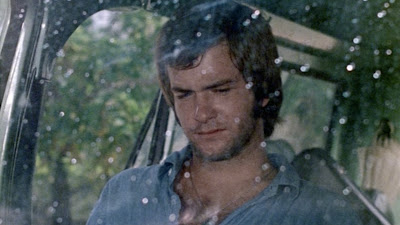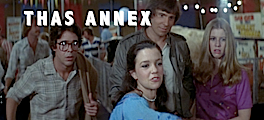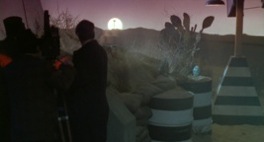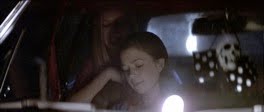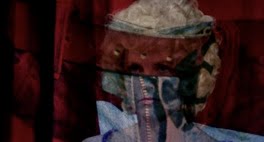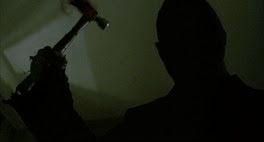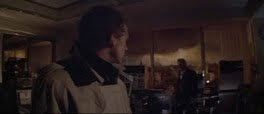As it turns out, Hooper's career is a story of the 80's--- and the decade is cordoned and cauterized like a disaster zone and severing crash, as Hooper made his slow and inexorable way through it, in all its market-oriented, neoliberal glory. He was allowed his time as the newcomer learning the ineffable ropes in the anthill that is Hollywood, fixing to be a regular studio Good Ol' Boy, but by the latter half of his glory run, the entertainment-based market and the escapism-desiring consumer ultimately rejected him - again, a careful mix of their shortcomings as well as his own - and Hooper ended up the Diminishing Returner with three consecutive commercial failures under the rhinestone belt.
And so the 90's came around, and Hooper, ejected from the A-list and never expecting to be handed a tent-pole again, began it damningly with the independently produced bungle Spontaneous Combustion. After that it was a work-for-hire for old boss Yoram Globus, for the ludicrous erotic horror film Night Terrors, then finally, he got a chance to reclaim mainstream horror with the cartoonish The Mangler, before falling off semi-permanently into the realm of television. Yet it is in these three films that Hooper's careful expressionism is fully uninhibited, unshackled from self-promises of fashionable endeavors, and let loose was his terribly artful indiscretion, or, more accurately probably, his woefully discreditable artfulness. Underneath mounds of camp production value, and a seeming inability on his part for simple chic, Hooper's 90's work exhibits an acceptance of the competence he will never have and an embrace of the uniquely thoughtful, uniquely felt sense of cinema innate to him. Persisting and exacerbated in his 90's triad is a gaucheness he can't seem to shake off, but realized more than ever is his rarefaction of the rarefied scene, his sculpting of scenes to a highly lofty point of embossed, brittle design that overwhelm narrative instead of the other way around. His act of rarefaction is his elevating of composition and construction (along with their thickness of mood and emotion) above the traditional denseness of narrative and drama. It is a knack of the notable filmmaker, to break narrative flow or dramatic lucidity for the boldness of the visual and structural performative. Like J.L. Austin's performative utterances in the field of rhetoric, the cinematic utterance communicates not through the meaning of the content but the theory of the locution - the how of the why we put artworks together in the first place. It is less a matter of what a work is meant or formulated to inspire in the audience (the "perlocutionary," to continue on the attributing of Hooper with the rhetorical), but what is felt by the artist that drives them to craft as they do. Hooper's sculpting reaches a degree of rarity and deliberation that it supersedes narratology, and what we end up with are films whose individual scenes can be isolated and marveled at in their fragile shape, their aesthetic and emotional involvement.
The following is a scene from The Mangler, a film whose portrait of industrialist malfeasance, the virginal working class pummeled deep within, and the transference of mechanistic evil I wish I could say wasn't so inane. Nevertheless, The Mangler acquits itself as Hooper's most polished 90's film and an incredibly fun film, with more style, wit, and buoyant entertainment than it is given credit for.
The following scene, against all odds of Robert Englund's appalling theatrics (and his even worse make-up), has a purity of vision, a raw clarity in its structured visual articulation - here we see clandestine exploitation and the prevaricating essence of coercion at its core, all through a driving, insistent, increasingly clenched shot-reverse shot.
The initial quote, asinine though it may be, gives effectively the context to the depicted scene.
THAS PRESENTS...
The Exquisite Shot-Reverse Shot
Case #2: The Mangler (1995)
"Chaos abounds, my dear. You'd better get used to it. Like I told you, there's no free lunch. No sirree bob, not in this lifetime. Still, life must be better here than on the streets, hmm? Here the predators are few. The benefits are many. For I am a generous man. I am a man of my word. Now then, why don't you go in there and freshen up for your Uncle Billy?"
SHOT 1:"Chaos abounds, my dear. You'd better get used to it. Like I told you, there's no free lunch. No sirree bob, not in this lifetime. Still, life must be better here than on the streets, hmm? Here the predators are few. The benefits are many. For I am a generous man. I am a man of my word. Now then, why don't you go in there and freshen up for your Uncle Billy?"

SHOT 2:

SHOT 3:

SHOT 4:


SHOT 5:

SHOT 6:


SHOT 7:

SHOT 8:

SHOT 9:

SHOT 10:

"Would you like to come in here and keep me company?"
SHOT 11:

With her decision, we go to her POV. The sickening, decrepit
unctuousness of Gartley (Englund) pierces even from a distance.

SHOT 12:

The camera soaks in her interiority, exquisitely making her and its
motions one and the same. The camera sits with her as she sits,
never leaving the tight shot of her face.



SHOT 13:


SHOT 14:



SHOT 15:

The cut back to Gartley is on his activating of his "lower half,"
bent over to snap the gears on, a grotesque preamble to his
salacious intentions.

SHOT 16:

SHOT 17:


SHOT 18:

The camera is pointedly of her POV, and the multiple, insistent, all-but-still
return shots to her face are the clearest structural appeal to the
audience. Our role as spectators is empathy, and it is our grandest
role where art is concerned.
SHOT 19:

SHOT 20:

"Lin Sue, Lin Sue, you sweet, young, woman."
SHOT 21:

SHOT 22:

SHOT 23:

"The only thing worse than the Devil within..."

"... is the Devil without."





























